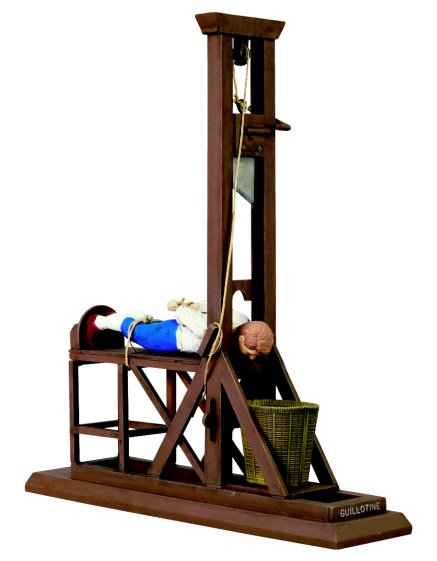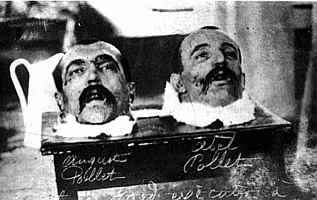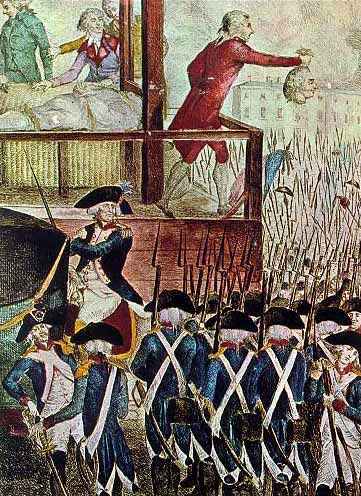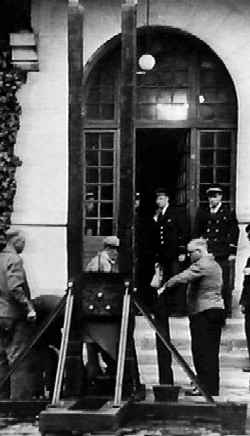|
Guillotine You can lop it off, or chop it off, hack it off, or whack it off, but no matter how you slice it, removing the head of another human being is tedious, messy and difficult.
You can lop it off, or chop it off, hack it off, or whack it off, but no matter how you slice it, removing the head of another human being is tedious, messy and difficult. Leave to the oh-so-civilized French to come up with a solution to this problem. Since heavy bladed weapons debuted around the time of the Bronze Age, beheading has been a favorite means of merciful capital punishment (relative to, say, crucifixion). For centuries, this was mostly accomplished using an axe or sword. But "merciful" decapitation was difficult work, requiring specialists with strong sword arms and precise aim. If the head doesn't come off on the first stroke, things can get ugly. Innovative inventors occasionally turned their attention to machines that would streamline the process of dislocating the head from the shoulders. While some of their efforts were perfectly functional, none of them really caught on outside of limited regional uses. A French doctor named Joseph Ignace Guillotin, elected as a legislator shortly after the start of the French Revolution, felt that the nation's current methods of execution hanging and beheading by sword were cruel and unusual. First, Guillotin proposed that capital punishment be abolished entirely. Unfortunately, there was a revolution going on, so that just wasn't gonna happen. As a compromise, and out of the purest humanitarian impulses, Guillotin proposed in late 1789 that all executions be performed using a beheading machine, which he felt was the most merciful method available.
In yet another example of why it never pays to do anything nice for anyone, the humanitarian and fervent opponent of the death penalty would be remembered by posterity as the guy who chopped people's heads off. Just to add injury to insult, it's not at all clear that the guillotine is an especially merciful means of execution. Some have estimated that a decapitated head could remain conscious for up to 30 seconds after being removed, offering the victim a truly unique perspective on the world for those last few moments. Although most credible accounts place the total duration of consciousness after decapitation at less than seven seconds, speculation to the contrary has been fueled by grotesque anecdotes about heads blinking or even trying to speak after being removed. Needless to say, there are no firsthand accounts to illuminate the subject.
The country became mired in intrigues, as the revolutionaries and the noble class tried to carve out new roles in the new order. After several false starts, the Revolution really got underway in 1792, when the monarchy was decisively ousted. Thousands of royalists were rounded up and jailed; about 2,000 were killed during riots, when angry mobs stormed the jails. The Revolutionaries, now firmly entrenched in the seats of power, immediately abandoned their high, idealistic aspirations of democracy and human rights in favor of rule by terror, and terror by guillotine. Originally proposed as a humane form of execution, the guillotine instead became a grisly public spectacle used to cow enemies of the regime. Under the iron fist of Maximilien Robespierre, thousands were marched to the guillotine. Those who weren't executed were forced to participate in such absurdities as an all-new metric calendar and a bizarre made-up religion called the Cult of the Supreme Being, a fucked-up fascist spirituality based around a nameless deity whom Robespierre described as "He who bathes with delicious tears the eyes of the son pressed to the bosom of his mother." Arguably, the guillotine was serving its original humanitarian purpose by delivering its victims from the clutches of this lunatic, although those people being beheaded might beg to differ. The first official execution by guillotine took place in April 1792, its subject a petty armed robber. But there were bigger and better things ahead. In August, the Revolutionary crackdown began, and thousands of subversives were rounded up and executed in public spectacles.
The victim's neck was placed below the blade, and the blade dropped from a height. A basket was usually placed under the victim's head to catch the noggin, although heads (being round) did have a tendency to roll away anyway. Unless, of course, someone was waiting there to grab it. One enterprising young woman named Marie Grosholz was a wax-model maker with a vision and connections within the Revolution. As the French royalty were executed one by one, she decided to preserve their visages for posterity by molding death masks from their decapitated heads. Later, Marie would be best known by her married name, under which she launched the now famous Madame Tussaud's Wax Museum, which exhibited the spoils of her labor. Marie molded the heads of some of the guillotine's most famous victims, including Queen Marie Antoinette and Robespierre, who fell victim to his own success in 1794. Although the guillotine's glory days came during the height of the French Revolution, its history hardly ended there. After its initial success in France, the machine was exported to other nations. Although similar devices had already been used throughout Europe, the guillotine proper became very popular in Germany, especially in Nazi Germany, where it was used for tens of thousands of executions during Hitler's tenure. The French themselves continued to use the device for nearly two centuries. The last public execution by guillotine was performed in 1939, but the device continued in use until 1977. In 1981, the French banned capital punishment, effectively bringing the guillotine's reign of terror to an end. (That's assuming, of course, that no one decides to mount a revival, which is probably not a safe assumption, given what we know about human history. We'll get back to you.)
Timeline
|
 Dr. Antoine Louis, the leading doctor of the day, designed a device to carry out the new law. Proud of his work, Louis called this device the louisette. But everyone else called it the guillotine, since the initial proposal was Guillotin's.
Dr. Antoine Louis, the leading doctor of the day, designed a device to carry out the new law. Proud of his work, Louis called this device the louisette. But everyone else called it the guillotine, since the initial proposal was Guillotin's.  As mentioned earlier, there was a revolution going on. The French Revolution made the American Revolution look like a day at the park. After centuries of monarchy, feudalism and virtual theocracy, the French threw out virtually every major institution of daily life, with bloody exuberance.
As mentioned earlier, there was a revolution going on. The French Revolution made the American Revolution look like a day at the park. After centuries of monarchy, feudalism and virtual theocracy, the French threw out virtually every major institution of daily life, with bloody exuberance. The guillotine itself was simply a sharp, heavy blade suspended by a rope and pulley system. Frills were added later, such as a stockade fitting for the head, a spring-loaded switch to set the blade in motion and a safety lock.
The guillotine itself was simply a sharp, heavy blade suspended by a rope and pulley system. Frills were added later, such as a stockade fitting for the head, a spring-loaded switch to set the blade in motion and a safety lock.